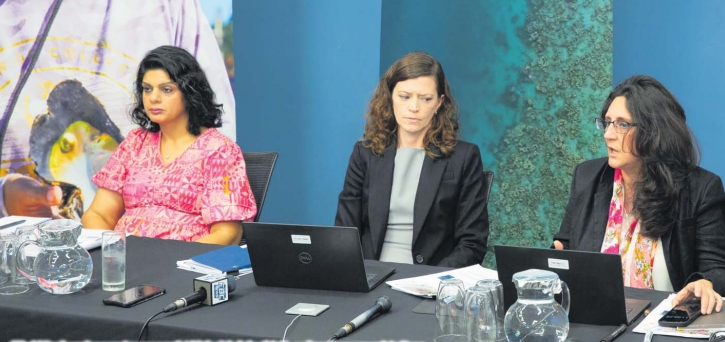Our Terms & Conditions | Our Privacy Policy
World Bank Report | Slow growth | Potential to broaden economic horizon Pacific
THIS week, the World Bank launched its October 2024 Pacific Economic Update that provides an assessment of the economies of 11 Pacific island countries (PICs). The report also highlights the potential of investment to broaden the economic horizons of the region.
Titled ‘Diminishing Growth amid Global Uncertainty: Ramping up Investment in the Pacific’, the report stated growth across the Pacific had fallen significantly to 3.6 percent this year, down from 5.8 percent in 2023. It stated the slowdown reflected the diminishing impact of the post-COVID pandemic recovery, particularly in Fiji, which accounts for over half of the output of the 11 PICs covered in this latest economic update, and due to structural challenges in the Solomon Islands.
The report projected Fiji’s growth to decelerate to 3.1 percent, down sharply from 8 percent in 2023 as economic activity returns to pre-pandemic levels. However, that is projected to recover slightly in 2025 in alignment with its pre-pandemic trend.
For Fiji, after a temporary rise to an estimated 5.2 percent this year, driven by VAT and other tax adjustments, inflation is expected to ease toward the Reserve Bank of Fiji’s (RBF) target of 3 percent in 2025, it stated.
“Fiji’s public debt, at 79.4 percent of GDP in 2024, is among the region’s highest. While increased revenues are expected to reduce the fiscal deficit, debt is projected to remain around 79 percent of GDP in the medium term — approximately 27 percent higher than pre-COVID levels,” the report stated.
Other key findings:
Inflation – eased significantly across the region with the median rate dropping from 6.8 percent in 2023 to 4 per cent in 2024.
The report noted inflation in Fiji is expected to average 3.6 percent in 2025-26 following a temporary spike this year because of tax adjustments. However, due to previous high inflation, the cost of essential goods remain elevated.
Fiscal balances – as a share of GDP have improved in several PICs as COVID-19 support measures were phased out and tax revenues improved. Thanks to these efforts and ongoing economic recovery, public debt as a share of GDP has decreased in over two-thirds of PICs since 2022, but the risk of debt distress remains high, driven by persistent disaster risks.
Medium-term growth – prospects in the region have dropped from an annual average of 3.2 percent in 2000-2019 to 2.7 percent in 2020-2029, driven by increasing natural disasters, climate change impacts, and weak investments. The report stated investment growth was projected at just 1 per cent annually in 2020-29, well below the 4.2 percent average from 2010-19.
Way forward for Investment
The World Bank is calling for a major boost in investment to address the region’s slowing economic growth; and the authors of the report have underscored the urgent need for targeted investment to create jobs, improve infrastructure, and build resilience against climate change, all amid global uncertainty. These actions are crucial for improving the livelihoods of Pacific communities and narrowing the income gap with higher-income nations.
To revive medium-term growth, World Bank senior economist Dana Vorisek said the Pacific needed to pursue strategies to generate sustainable investment.
She said there had been a slowdown in investment in emerging markets and developing economies, and the Pacific had not avoided the same.
“Another big trend we have seen in the Pacific is that investment has a high incidence of shrinking when you’re looking at a year-to-year trend,” Ms Vorisek said at a press conference in Suva.
The October report offers six key recommendations to drive investment and ensure local communities benefit from economic growth, and include:
r Enabling investment into high-potential sectors: To modernise agriculture by prioritising high-value crops, while fostering agribusiness development; advance the ‘blue economy’; and diversify the tourism sector and promote sustainable commodity production and mining, ensuring these sectors collaborate to attract investment and drive inclusive economic growth;
r Address infrastructure deficiencies: The report recommends enhancing road infrastructure and connectivity to improve access to markets, expand and upgrade port and airport facilities to boost trade, promote competitiveness, and prioritise energy and internet access and efficiency, leveraging the potential of renewable energy development;
r Build resilience, including fiscal resilience, against disasters: Invest in climate-resilient infrastructure, including coastal protection and drainage systems, promote sustainable land use and conservation to reduce vulnerability to disasters and support long-term economic growth, boost domestic revenue, and improve fiscal and investment management for more effective budget planning and execution;
r Establish supportive regulatory and policy framework to attract private investment: To establish a robust legal and policy framework for State-owned enterprises. Including regular audits, transparent reporting, effective internal controls, and clear definitions of ownership, improve effectiveness of PPPs, reduce red tape and adjust investment incentives to attract private investors to high-potential sectors;
r Improve availability of financing and insurance products: Develop innovative financial instruments to provide stable funding for major private or public investment projects, and finance post-disaster infrastructure recovery projects and climate-related investments; and create tailor-made insurance products for infrastructure development and disaster risks; and
r Level global support: Secure timely international financial institution funding and technical expertise for high-impact projects, and engage in collaborative approaches with global and regional partners to share knowledge and enhance investment strategies.
World Bank senior economist Ekaterine Vashakmadze said though growth and investments had slowed, there are projections it will accelerate and the Pacific region needed to collectively make some efforts to accelerate these and draw up policies that will allow PICs to take advantage of growth opportunities.
Images are for reference only.Images and contents gathered automatic from google or 3rd party sources.All rights on the images and contents are with their legal original owners.



Comments are closed.